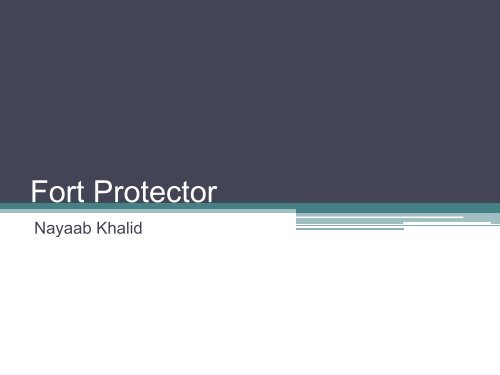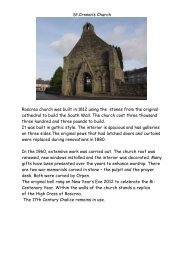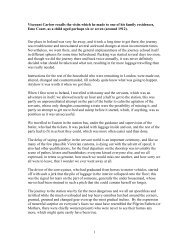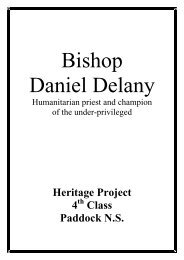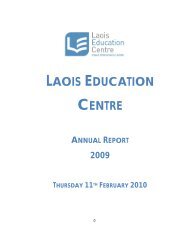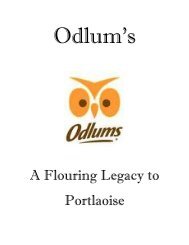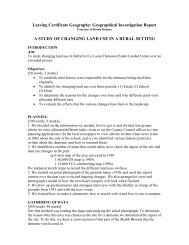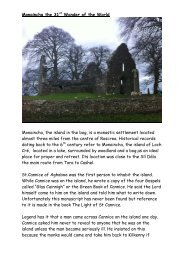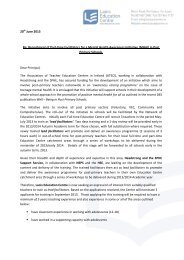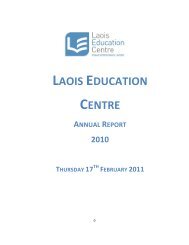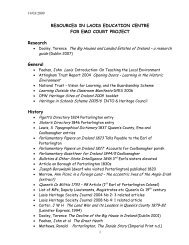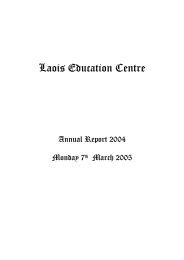Fort Protector - Laois education Centre
Fort Protector - Laois education Centre
Fort Protector - Laois education Centre
You also want an ePaper? Increase the reach of your titles
YUMPU automatically turns print PDFs into web optimized ePapers that Google loves.
<strong>Fort</strong> <strong>Protector</strong><br />
Nayaab Khalid
The Birthplace of the British Empire<br />
• The town grew up around a fort established by<br />
English settlers in 1548.<br />
• This happened half a century before the<br />
founding of Jamestown, Virginia which marked<br />
the beginning of English colonisation in America.<br />
• So without any exaggeration it can be claimed<br />
that Portlaoise was the birthplace of the British<br />
empire.
• The O’Moores of <strong>Laois</strong> and O’Connors of Offaly had<br />
terrorised the English settlers of the Pale and<br />
extorted black rents from them following the failure<br />
of the Silken Thomas rebellion. When in 1547 they<br />
rose in rebellion again, military expeditions were<br />
dispatched under St. Leger (and later Bellingham) to<br />
subdue them.<br />
• The military campaign was successful. Giolla Patrick<br />
O Moore and Brian o Connor were defeated and<br />
brought under arrest to England. There, their lives<br />
were spared but their lands confiscated. The fort of<br />
<strong>Laois</strong>, from which the town is named, began in<br />
1547-48.
Portlaoise<br />
• A historic town founded over four hundred years<br />
ago to advance the English colonisation of Ireland.<br />
• Nowadays many of its historic remains lie concealed<br />
from the thousands of people who pass through it<br />
every week.<br />
• The relative dearth of easily visible historical<br />
remains is partly due to the violence of Portlaoise’s<br />
early history, but also to the rapid growth and<br />
expansion of the town in recent years.
Portlaoise<br />
• The present town grew around the old fort, the<br />
construction for which began in the year 1548<br />
under the supervision of the lord deputy Sir<br />
Edward Bellingham.
Who Built It?<br />
•Lord Deputy<br />
Sir Edward<br />
Bellingham
Its Purpose<br />
• The fort was built primarily for military and<br />
political purposes.<br />
• Its situation on rising ground southeast of the<br />
river Triogue and with the Esker ridge forming a<br />
natural defensive barricade to the east made it<br />
of strategic military importance.
Why was it Built?<br />
• Lord Deputy Sir Edward Bellingham was<br />
anxious to fortify <strong>Laois</strong> following his repression<br />
of the natives and the exiling of their chieftains<br />
earlier in the year.<br />
• It was built to protect the English who were<br />
brought in the O’Moore territory and also to<br />
guard the southern flank of the Pale.
The <strong>Fort</strong><br />
• The fort was initially named fort of Leix or <strong>Fort</strong><br />
<strong>Protector</strong> in honour of the Earl of Somerset, the<br />
Lord <strong>Protector</strong> of England.<br />
• However in 1557, under two important Acts passed<br />
in the parliament of King Philip and Queen Mary, the<br />
town was renamed Maryborough and the county<br />
was given the title Queen’s County.<br />
• In the year 1558 the fort of Maryborough was<br />
garrisoned and for the next half century the<br />
O’Moores, the native chiefs of <strong>Laois</strong>, waged war on<br />
the settlers.
The <strong>Fort</strong><br />
• The fort occupied the area where Fitzmaurice<br />
Place, the convent and the old Vocational<br />
School (the tech) stand today.<br />
• The only visible remains of the fort are a circular<br />
tower and small portions of the wall.<br />
• The fort was initially called <strong>Fort</strong> <strong>Protector</strong> in<br />
honour of the earl of Somerset, Lord <strong>Protector</strong> of<br />
England.
Maryborough<br />
• In 1570, Queen Elizabeth granted a charter of<br />
incorporation and throughout the second half of<br />
the 16 th century, Maryborough remained the<br />
only town in the county.<br />
• This charter raised the town of Maryborough to<br />
the rank of Borough. The corporation of the<br />
Borough consisted of a Burgomaster, two<br />
bailiffs, Burgesses and freemen, a town clerk, a<br />
Sergeant at arms and inferior officers.
The Corporation of the Borough<br />
• The town returned two members to the Irish<br />
Parliament until the Act of Union when the<br />
franchise was abolished. The corporation of<br />
Maryborough lasted until 1830.
• During the war of 1641, it was captured by<br />
Catholic forces and nine years later by Oliver<br />
Cromwell’s troops.<br />
• In the late 1650s, with a population of 198 (150<br />
Irish, 48 English) Maryborough was the third<br />
largest town in the county behind Ballinakill<br />
(204) and Mountrath (223)
Cromwellian Rule<br />
• During Cromwell’s reign in Ireland, Maryborough<br />
was taken and the fort was demolished by the<br />
Cromwellian forces under Colonels Hewson and<br />
Reynolds.<br />
• It was out of the ashes of this devastation of the fort<br />
that the town of Maryborough arose and became a<br />
market town and the administrative centre of the<br />
area.<br />
• The town was the seat of the Queen’s County<br />
Assizes and the HQs of the County Constabulary<br />
force.<br />
• In 1922 the town was renamed Portlaoise.
• The early fort was variously known as governor, port<br />
laois, Campa and <strong>Fort</strong> <strong>Protector</strong>.


